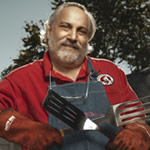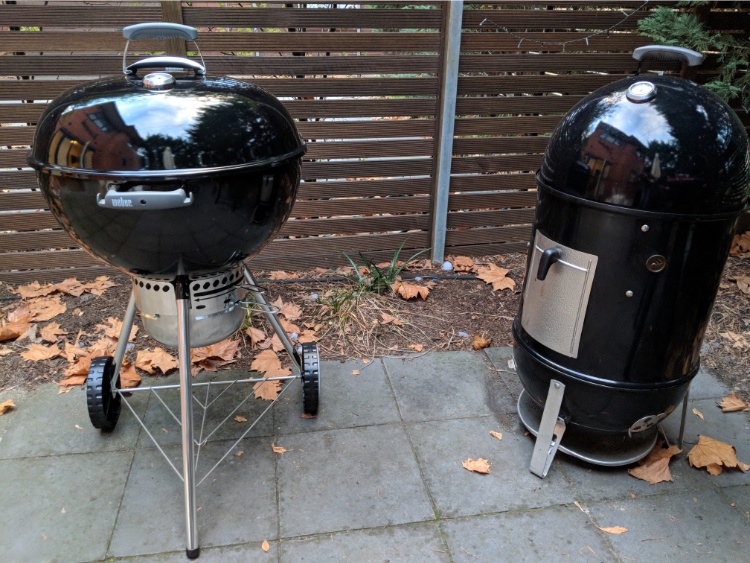If you are ready to get serious about smoking meat, chances are you are seriously considering picking up a Weber Smokey Mountain.
The Smokey Mountain was the first dedicated smoker I purchased way back when I was learning to barbecue, so it’s near and dear to my heart.
In this review I’ll go through how it compares to other popular smokers, how to choose the right size, and how to get the most out of your new smoker.
Weber Smokey Mountain Overview
The iconic Weber Smokey Mountain has built up a massive cult following among smoked meat enthusiasts.
Also known as the Weber Bullet, this smoker has a rich history. First introduced in 1981, the WSM has undergone several improvements over the years, including new sizes, built-in thermometer, improved construction, and many more.
The WSM has built a reputation among even the most serious pitmasters.

Meathead Goldwyn, Weber Smokey Mountain Cooker
“WSMs are high quality, charcoal fueled, bullet-shaped smokers. They are often seen competing head to head with large commercial cookers at practically every competition. And winning. They take very little time to master
Smokey Mountains cook at a remarkably steady temp for hours and raising or lowering temp on this small model is fairly easy by opening and closing the vents.
Construction is solid and finish is beautiful. Weber really knows how to make long lasting porcelain and chrome coatings. The legs are sturdy and there is a bowl-shaped aluminum heat shield attached to them. If you cook on a wood deck, we recommend setting your WSM on a grill mat.”
The Smokey Mountain falls into the water smoker family.
Resembling a bullet (another nickname), they pack a lot of punch into a small size. Great if you are short on space.
The Smokey Mountain uses charcoal & wood chunks to generate smoke and heat.
One key feature is the water bowl which sits between the fire and the cooking greats. The water bowl helps to maintain a stable smoking temperature, while also adding humidity to the smoke chamber.
Many WSM fans believe this feature allows them to skip the “Texas crutch” step of wrapping the meat in foil partway through the cook.
A water smoker is typically made up of three sections:
- A firebox where the charcoal & smoke wood go and a grate to control airflow
- A cooking section containing the water pan, two cooking grates and an access door for adding charcoal or wood
- Weber domed lid with built-in temperature gauge
One of the main reasons people prefer vertical water smokers like the WSM over other smokers is because they are easy to use.
Even a total beginner can get started smoking with a WSM and get good results.
Heck, I learned to smoke on a Weber Smokey Mountain, and my first few cooks came out pretty good.
What I like:
- Great for both beginners & advanced – I found the WSM extremely forgiving when first learning how to manage airflow and control temperatures. This reliability makes it a popular choice on the competition circuit.
- Fits a lot of food in a small footprint – The vertical design with two grill grates gives you excellent cooking capacity for smaller spaces.
What I don’t like:
- Flimsy side door – The one weak piece of engineering is the side door used to add charcoal during a cook.
Check out the Resources section at the bottom of this post for more advice on cooking with a Smokey Mountain.
Which Smokey Mountain size should you buy
Since 2014, the Weber Smokey Mountain has been available in 3 sizes.
The newest scaled-down model clocks in at 14″, then there is the 18″ model and the big daddy 22″ Smokey Mountain Cooker.
In each case, the size in the name refers to the width of the cooking grates.
Price per inch (each WSM come with 2 grates):
14.5″ – 276 sq in – $0.72 per sq in
18.5″ – 481 sq in – $0.62 per sq in
22.5″ – 726 sq in – $0.55 per sq in
Think carefully about what you plan on cooking.
If you buy the smaller model to save money but can’t fit a large enough brisket you might end up having to buy both and have two smokers clogging up the yard (not the worst problem to have!)
Key things to consider
- Think about the largest item you’ll likely be smoking (Usually a packer brisket or turkey).
- I’ve never had a problem fitting a brisket or whole rack of ribs on my 18.5″ model.
- The larger Smokey Mountains will burn through more charcoal
- Are you going to be using the WSM as a dedicated smoker, or as a smoker/grill combo? If you’re going to be grilling then 22.5″ is your best bet although it’s not designed to grill.
Deciding which Weber to buy really comes down to 2 things:
- Price – If you can afford it get the 22″ WSM and you won’t have to worry about running out of space.
- How many people you need to cook for – If you plan on regularly cooking multiple chickens or racks of ribs then I would recommend investing the extra money to get at least the 18 inch model.
Personally, I went for the middle 18″ version and I couldn’t be happier. I find I can fit two medium chickens on one rack and can do a pork butt or a few racks of ribs on the other grill.
Smokey Mountain alternatives compared
One of the most common questions people worry about before buying a Smokey Mountain is how it compares with other popular smokers.
The Smokey Mountain gets very high ratings everywhere you look and is a common sight to see at barbecue competitions.
With that said it’s still worth checking out how the WSM compares to other popular smokers.
Weber Smokey Mountain VS Kettle Grill
If you’re upgrading to a dedicated smoker it’s likely you already own a Kettle Grill so feel free to skip ahead.
If this is your first smoker though, you might be wondering if it’s worth spending a few hundred on a Smokey Mountain, when you can buy a standard Weber Kettle Grill for around a hundred dollars.

It comes down to what’s most important to you. The Weber Kettle is cheaper and more versatile. While designed as a grill, the Kettle can be converted into a smoker relatively easily.
But if you are serious about smoking meat, the WSM is a significantly better smoker. Compared to a Kettle, the WSM will give you:
- Significantly more stable temperature – Smoking meat requires consistent heat over long amounts of time. While this can be done with a Kettle, it requires regularly adjusting the airflow and can take a lot of practice (and sub-par BBQ) to perfect. The WSM, on the other hand, can go for hours and hours without a fuss.
- Maintain lower temperatures – As well as better overall temperature control, the WSM allows you to maintain lower temperatures without the risk of temperature spikes. With the Kettle, you will always be battling direct heat radiation.
- Amount of food you can fit – With the dual grill design, and avoiding the multi zone cooking required with a Kettle, you get significantly more cooking area.
- Cold smoking – If you want to try cold smoking fish or cheese you have a few options with the WSM. You can use the snake method with stacks of 2×2 charcoal with wood on top and then fill the reservoir with ice. Or if you want less fuss you can invest in a pellet smoker tube to place in the bottom of your grill
The Weber Kettle is a great, versatile grill. With some practice and lots of optional accessories, you can achieve good results smoking meat.
If you don’t usually smoke much meat at a time, then the Kettle may also be a better bet. But if you want to get serious the Smokey Mountain is hands down a better meat smoker and well worth the extra investment.
Weber Smokey Mountain VS BIG Green Egg
The Weber Smokey Mountain is often compared with the Big Green Egg despite the BGE being a Kamado Cooker. This type of cooker named from the Japanese word for “stove” can be made from a variety of materials including ceramic.
Why would you buy this distinctively designed Kamado style smoker you might ask?

Meathead Goldwyn, Big Green Egg Ceramic Cooker
“For many, the Big Green Egg is the Weber of Kamados. They introduced Kamado cookers to the USA and are often viewed as the industry standard.
The Large Egg is big enough for a 20 pound turkey and has an 18″ diameter grate. Made in Mexico the BGE design is simple, it is built to last, and it has a limited lifetime warranty.
Round Kamados work as good as or better than standard charcoal grills for most recipes. They are, by design, excellent ovens and smokers because once the ceramic settles at the desired temperature, it stays there for hours”
Some advantages of buying the Big Green Egg
- The largest advantage that fans of the Big Green Egg claim is superior air control and insulation.
- The WSM is less efficient and will burn more fuel.
- If you do much cooking in lower temperatures, the ceramic Big Green Egg will be much less affected by cold weather & snow.
- Can double as an oven without any modifications.
- Easily cook pizza, bread and anything else you would normally cook in an oven. WSM can do this too but requires a Pizza Oven Kit (and you’ll also need to remove the center section of your WSM).
The BGE is a better combo grill but for the purpose of this guide, we are focusing on what makes the best smoker. And for what it’s worth the BGE doesn’t tick the box for Meathead Goldwyn either as it cannot be set up for true 2-zone cooking.
Before we crown the BGE…
The BGE sounds great so far, but we’ve been ignoring the elephant in the room. The BGE will set you back significantly more cash.
With the WSM you’ll be getting more cooking space for a smaller investment than the BGE, especially if you are comparing the 22.5″ model.
Large Big Green Egg – 262 square inches
XL Big Green Egg – 452 square inches
18.5″ WSM – 481 square inches
22.5″ WSM – 726 square inches
- Making the WSM significantly more affordable! Even the largest WSM will set you back a lot less than the $849.00 for the Large BGE.
- That’s only the suggested retail price as Big Green Eggs are only sold my authorized dealers.
- With the 22.5″ WSM you are only paying $0.55 per sq in VS $3.20 for the Large BGE
“The BGE is 481.8% more expensive per square inch of cooking surface”
The simple fact is for a lot of people the price will force them to choose the WSM over the BGE. But if price isn’t an issue and you demand the highest level of temperature control the the BGE might be for you.
If you’re interested in this style of smoker, we have an in-depth guide to the best Kamado grills.
Offset Smoker VS WSM
Offset smokers (also known as horizontal smokers) are another popular choice for people looking to get serious about smoking meat. While the cooking principles are the same, fire management is a completely different experience on a offset style smoker.
And then there is the matter of price. With a good offset smokers costing upwards of $1,000 you might think they represent an upgrade over the WSM.
But what you’re really paying for is extra capacity at the expense of burning through a lot of fuel and having to tend the fire a lot more to maintain a stable temperature.
Even with the 12.5” WSM you are getting a top quality smoker. An offset smoker around that price point might make a good table, but won’t be useful for much else.
Main differences between an offset and a WSM
- Offset smoker will typically have more capacity which is good if you need to cook a lot of meat at once.
- If you have a readily available source of cheap appropriate firewood like oak, hickory, cedar or maple.
- The WSM offers more of a “set it and forget it” type of cooker, whereas the offset smoker involves a lot more fire management.
The WSM ends up being much more economical both in terms of price and fuel. The general consensus is that the Weber gives you better temperature control.
If want to play around with burning wood and you don’t mind spending extra then there are some good offsets out there, but the WSM is hands down better value.
WSM VS Traeger pellet smoker
So far every smoker we’ve looked at uses charcoal (or wood). But if all this talk of fire management has got you concerned there’s another option that’s worth considering.
Pallet smokers look like offset smokers, but instead of a firebox you have a side mounted hopper filled with cylindrical wood pellets. These pellets are delivered from the hopper to a fire pot with an ignition. The heat and smoke from the pellets combustion smokes the meat.

Pellet smokers draw household electrical current and come with a digital controller that allows you to select any temperature you want.

Steven Raichlen, New Kid on the Block: Pellet Grills
“It’s easy—maybe a little too easy,” I told the crowd of Barbecue University students gathered around the first wood pellet grill many had seen. People nodded—we had an understanding, right?
Smoking and barbecuing are supposed to be hard work. If not chopping wood, then at least breathing in charcoal dust and smoke and laboring to maintain a steady temperature during a barbecue session that could last the better part of a day. Or night.
Certainly no self-respecting pit master would subscribe to a “set it and forget it” philosophy. Pellet grills are a fad, I thought to myself, that will flame out fast.
That was five years ago.
Traeger are decent middle of the range pellet smokers. With excellent control, convenience and great taste, Traeger pellet grills have earned the reputation of “Big cheating outdoor oven!”.
- If you don’t enjoy the process of tinkering over the fire / charcaol, and don’t want to worry about heat management the Traeger could be a good option
- The WSM will still give you better value, with the cheaper Traeger grill costing more for 292 square inchs of cooking surface compared to 481 square inches on the 18.5” WSM.
If you don’t mind paying a bit extra for the “set it and forget it” approach, and you’re sure you won’t miss the heat management a Traeger is a good option. It does remove some of the fun and romance of smoking in my opinion.
That covers off some of the major Smokey Mountain alternatives that people often compare. Hopefully I’ve provided enough information for you to make up your own mind.
How to setup your new Smokey Mountain
Assuming you’ve decided to purchase your own WSM there are a few things you need to know first. Before you start cooking with your new WSM it’s important that to get some essential smoker accessories. These will make your life a whole lot easier.
At the bare minimum you will want a quality wireless thermometer and a chimney starter. After that you can shop around for other accessories as you need them. While by no means essential, a some people end up doing their own mods to the Smokey Mountain like adding a hinge to the lid, fixing leaks or adding wheels.
Just like a good cast iron pan or wok, it’s important to season your new WSM before cooking with it.

Harry Soo – Seasoning a new WSM
“Phase One – Cover the water pan completely with aluminum foil and run a full load of lit Kingsford blue bag briquets and let it run as hot as it can with no water in the pan (over 350°F) to burn off any manufacturing residue. Clean out the ash.
Phase Two -Fill the charcoal basket 1/2 full of unlit briquets. Hollow out the center so you can see the grate, amking a donut of charcoal. Then put in a 1/2 chimney of lit Kingsford briquets in the middle. This will allow a slow burn for three to five hours on a 72°F day.
Adjust the vents to get 275°F on the dome thermometer. Put in bacon strips, chicken parts, pork fat, or any other scrap meat you don’t plan to eat. The key is to get fatty meats to generate lots of vapors. Toss in a couple of tennis ball size wood chunks to generate smoke.
Repeat the above step at least twice before you cook meat that you want to eat. Remember to always empty the ash from the bottom and grease on the foiled water pan to avoid fires and any rancid old oil smell before you cook.”
It’s also important to master temperature control on your new smoker. While the basics are easy it’s good to understand a bit of the science behind temperature, and how to avoid making some of the common newbie mistakes.
Basic setup for the Smokey Mountain
- Lit charcoal is piled in the charcoal ring at the bottom
- Fill the metal bowl with water or experiment with other liquids like cider or apple juice (or even beer if you can spare it)
- Food goes on to the racks above the water bowl
- Add wood chunks to the coals and adjust the vents to obtain desired temperature of 225 degrees
- Check the temperature every hour or so (The WSM comes with a built in thermometer but most people prefer to buy something more accurate like a ThermoWorks Smoke
Where to Buy your new Smokey Mountain
When it comes to actually buy your new WSM you have a couple of options. The easiest options are via Amazon or the Weber website.
The WSM rarely (if ever) goes on sale but if you want to save money you can also usually find some good second-hand Weber Smokey Mountains on Ebay.
Resources for getting the most out of your new WSM
http://virtualweberbullet.com/ – Probably the best resource for in-depth WSM information. From history, product info, unboxing to tips and tricks for using your new WSM.
http://tvwbb.com/ – A discussion forum connected to the virtualweberbullet. With millions of posts you can find the answer to any question. Great community for discussing your WSM.
The best setup and add-ons for a WSM – In depth guide to setting up your WSM, seasoning and different cooking methods.
Smoking Some Barbecue Baby Back Ribs (Video) – Watch a WSM in action smoking ribs.
Smoking Amazing Ribs with a WSM – Step by step guide to smoking ribs on the WSM with lots of pictures so it’s easy to follow along.
Feeding the Fire: Recipes and Strategies for Better Barbecue and Grilling – This BBQ book by Joe Carroll isn’t specific for a WSM, but the advice contained within all applies to using your new WSM.
Secrets to Smoking on the Weber Smokey Mountain Cooker – Good range of recipes to get you started smoking with the WSM as well as technique.
Well that concludes this ultimate guide to buying a Smokey Mountain. Hopefully you’ve found some useful information to make your decision easier. Leave a comment if there is anything you think I’ve missed that would be useful.
 Backyard GrillingWeekend WarriorsAdvice from DadBeard GroomingTV Shows for Guys4x4 Off-Road CarsMens FashionSports NewsAncient Archeology World NewsPrivacy PolicyTerms And Conditions
Backyard GrillingWeekend WarriorsAdvice from DadBeard GroomingTV Shows for Guys4x4 Off-Road CarsMens FashionSports NewsAncient Archeology World NewsPrivacy PolicyTerms And Conditions
